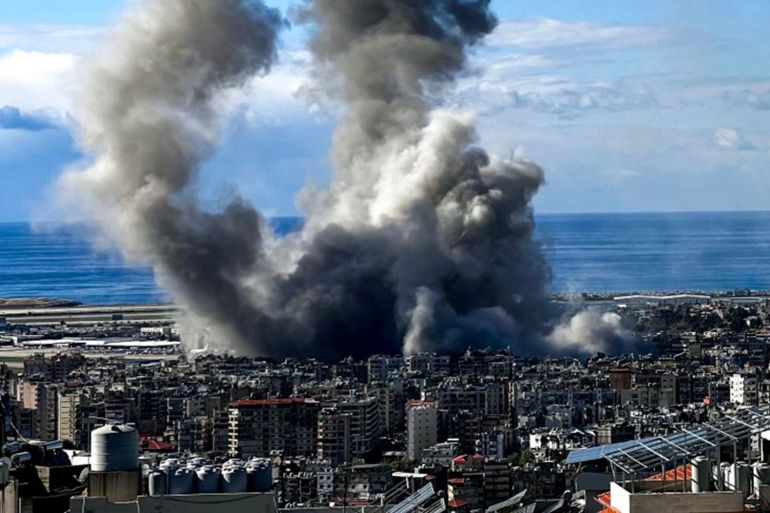A woman walks past a building damaged by Israeli airstrikes on Tayouneh in Beirut’s suburban outskirts on November 25, 2024 [Ibrahim Amri/AFP]
A ceasefire between Hezbollah and Israel has begun, but what are the details and will it hold?
Beirut, Lebanon – Lebanon has approved a ceasefire agreement with Israel, representing all factions of the Lebanese people, including the Hezbollah group.
Israel’s cabinet approved the ceasefire on Tuesday night and hostilities ceased at 4am on Wednesday.
The agreement stands to end more than a year of violence that began when Hezbollah began launching strikes at Israel on October 8, 2023, saying it would continue as long as Israel conducted its war on the people of Gaza.
Since October 2023, Israel has uprooted 1.2 million people in Lebanon and killed 3,768, most of them killed in the past two months.
Hezbollah – and its Lebanese rivals and allies – support an end to the war, but what are the terms of the ceasefire, where is it at right now, and will it hold?
Has the ceasefire started?
Now that all parties to the ceasefire have approved it, it is considered to be in force.
Hostilities ceased at 4am, about six hours before Lebanon’s formal acceptance of the pact.
What does the ceasefire involve?
Israeli troops should withdraw from southern Lebanon, and Hezbollah pull back north of the Litani River, ending its presence in the south.
This would take 60 days, and the Lebanese army, which has largely remained a bystander in the current war, would deploy to the south to monitor the ceasefire.

(Al Jazeera)
An international task force – headed by the United States and including French peacekeepers – would also be deployed to oversee implementation.
The Lebanese army will be required to expand its role in Lebanon, most notably in the south where it would become the only armed body and take over all arms-related activity in the country.
What about the people who had to leave their homes?
Lebanese and Israeli civilians should be allowed to gradually return to their homes.
The destruction in the south of Lebanon is so extensive, however, that it is hard to tell how many people will try to return there.
On the Israeli side, residents from the north may or may not return as many are expected to distrust the ceasefire.
Will the ceasefire hold?
Well, at least for a few years, experts say.
“Without a comprehensive political agreement involving Iran, the ceasefire risks being a temporary measure,” Imad Salamey, a professor of political science at the Lebanese American University, told Al Jazeera.
“Even under these circumstances, the ceasefire would likely buy several years of relative peace,” he added.
Other analysts are less optimistic, with Haaretz columnist Alon Pinkas telling Al Jazeera that the agreement – based on reported details – appears very fragile and impossible to implement, especially where it relies on the Lebanese army expanding its role.

Israel has demanded the right to strike Lebanon to “enforce” the terms of the ceasefire if the Lebanese army and international task force fail to keep Hezbollah out of the borderlands.
Accepting Israel’s demand, experts say, would mean international “authorisation” that Israel regularly violate Lebanon’s sovereignty whenever it sees fit.
“We could be entering a new phase… perhaps the Syrianisation [of Lebanon],” said Karim Emile Batar, an expert on Lebanon and an associate professor of international relations at Lebanon’s Saint Joseph University.
Lebanon has long objected to the idea that Israel could have the right to strike its territory at will, asserting that it would be a violation of its sovereignty.
It’s unclear whether this clause will be included in the ceasefire or if it will be part of a separate agreement between the US and Israel.

Israel has destroyed about 37 villages and flattened major neighbourhoods in Beirut, Nabatieh and Tyre.
Most of the people uprooted are Shia Muslims – a demographic that Hezbollah draws most of its support from – who won’t be able to return to their villages for the foreseeable future.
Their protracted and unprecedented displacement could strain relations with host communities who belong to other religious sects.
Lebanon’s sectarian communities suffered acute violence during the Lebanese Civil War from 1975 to 1990. That violence led to mass displacement and the geographic segregation of Lebanon’s main sectarian communities.
These communities will now be forced to live with each other without much support from the caretaker government, which is reeling from an acute economic crisis.
What’s next for Hezbollah?
The presence of the international task force and the domestic opposition to Hezbollah’s militarised role makes it challenging for the group to regain its previous strength, according to Salamey.
“Hezbollah may be compelled to shift its focus inward, seeking to secure its relevance within the Lebanese state rather than through external military operations, thereby positioning itself for a role in shaping Lebanon’s future political landscape,” he told Al Jazeera.
Source: Al Jazeera
Post Disclaimer
Disclaimer: Ceasefire between Lebanon’s Hezbollah and Israel: What to know By Mat Nashed - Views expressed by writers in this section are their own and do not necessarily reflect www.globalmuslimscenario.com/ point-of-view
Post Disclaimer |
IMPORTANT : All content hosted on globalmuslimscenario.com is solely for non-commercial purposes and with the permission of original copyright holders. Any other use of the hosted content, such as for financial gain, requires express approval from the copyright owners.